A few days in Khajuraho, Madhya Pradesh, India
If you’ve never heard of Khajuraho, it’s not surprising. In terms of tourism in India, it is far less well-known than, say, Agra, home to the Taj Mahal, or big cities like Mumbai or Delhi. On the other hand, you may very well be familiar with images from Khajuraho. Pictures like this one below:
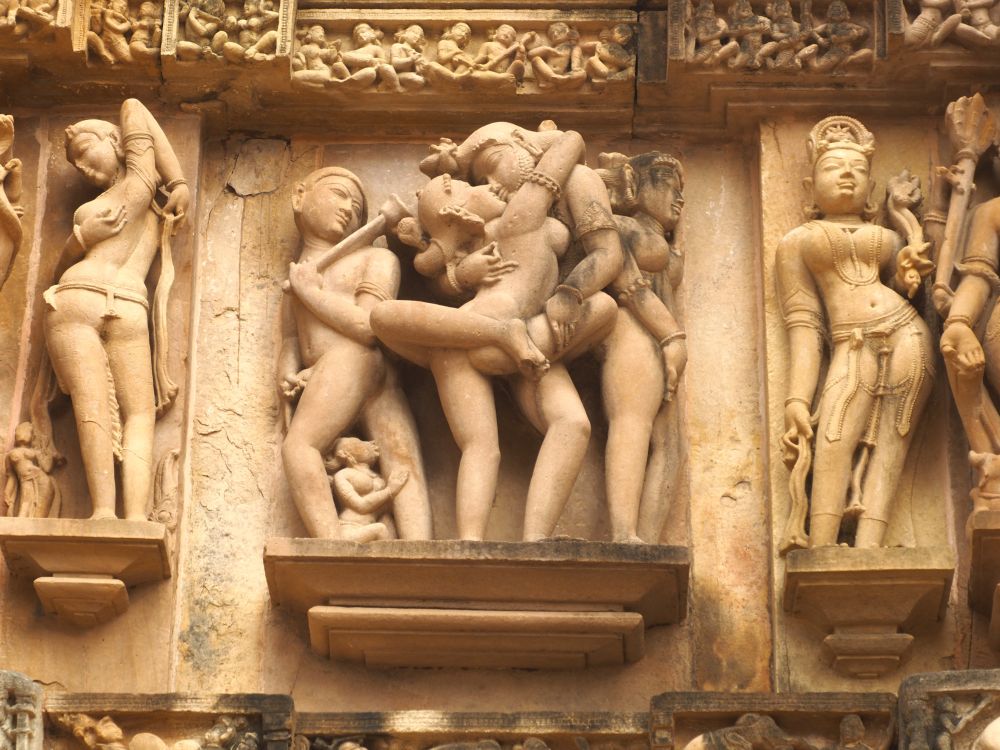
Khajuraho is home to a UNESCO site called Khajuraho Group of Monuments, which is where these erotic images come from. They’re also why it’s a tourist destination, even when the town of Khajuraho itself is basically just a small agricultural village.
These monuments are definitely worth seeing, not so much for the erotic images as for the sheer quantity of images in general, plus the architecture of the temples they decorate. But there are other sights worth seeing in Khajuraho too. In this article I’ll describe the main three places: the UNESCO site, but also two nature reserves.
Disclosure: This article contains affiliate links. Making a purchase through an affiliate link will mean a small commission for this website. This will not affect your price.
Khajuraho Group of Monuments
There are about 22 temples left in Khajuraho from the original 85. They were built in the 10th-11th century when Khajuraho was the religious capital for the Chandela empire. While they stand in three groups – Western, Eastern and Southern – it’s the Western Group that has the most impressive and intact temples.
The architecture is different from any temples I’ve seen before, and all of the temples have the same linear plan. They stand on a high platform because they were once surrounded by a lake, so the platforms created islands. Each has a stairway to its entrance. Inside the entrance portal is a hall, with a smaller sanctuary beyond that.
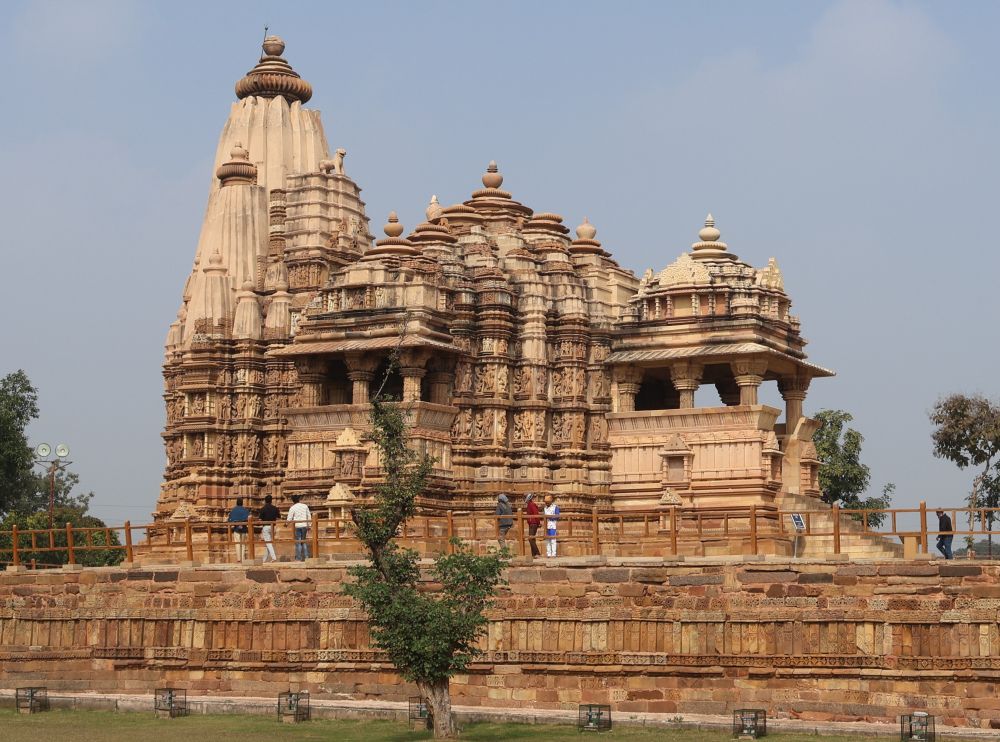
What is special about these temples, though, is the stonework covering them outside and, in many temples, inside as well. The images start around the base, showing armies at battle and scenes of daily life.
On the temple walls themselves, the images are generally – but not always – larger, and they depict humans and gods engaged in various activities. Some of the female figures pose provocatively, or they do yoga or arrange their hair. In some (about 5-10%) of the images, you’ll see male and female figures engaging in sex in various combinations and positions.
We heard two different interpretations of the erotic images. Our tour guide insisted that most of them were meant to be Tantric images: showing sexuality more as a metaphor of the oneness and balance between male and female. The co-owner of the guesthouse where we stayed, who is in training to be a licensed tour guide, had a different explanation. He said that the Chandela rulers needed a larger population to hold their power, and the carvings, including the sexual ones, were meant to teach the uneducated about their belief system but also to encourage them to procreate. Sexuality, he told us, was seen as a way to quiet one’s head. That, in turn, allows you to focus on the religious precepts.
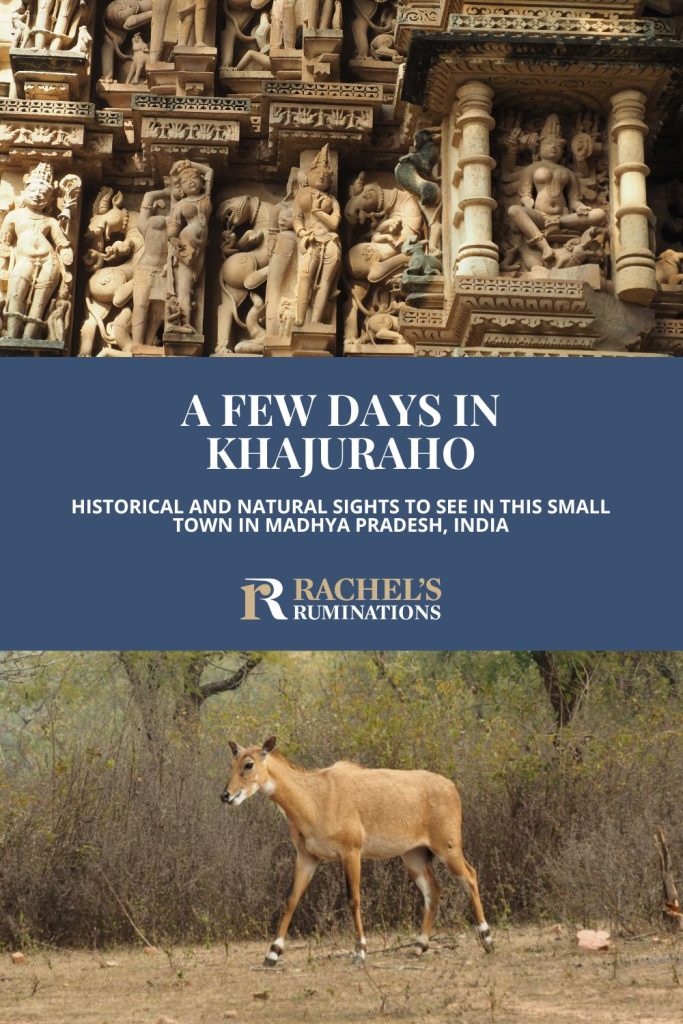
Anyway, the temples of the Western Group are fascinating. It’s fun to find the different god images as well as the sexual ones tucked among them.
If you haven’t had enough of temples, you can also visit the Eastern and Southern groups. The Southern group only has a few remaining temples, but the biggest one there has a lot of erotic images. The Eastern Group is on the grounds of a modern Jain temple. While the temples are smaller, the artwork is even less damaged than in the other two groups.
The ticket to the temples gives you same-day access to a small archaeological museum (at a different location), in case the thousands of images on the temples themselves aren’t enough.
Website of the Archaeological Survey of India.
Raneh Falls Ken Ghariyal Sanctuary
About a half-hour outside of Khajuraho, this destination has two parts. Raneh waterfall descends into the Ken River here, and the Ken River runs through a huge gorge, “the Grand Canyon of India.” Having seen the Grand Canyon, I can say that they are not alike, but nevertheless it’s an impressive gorge.
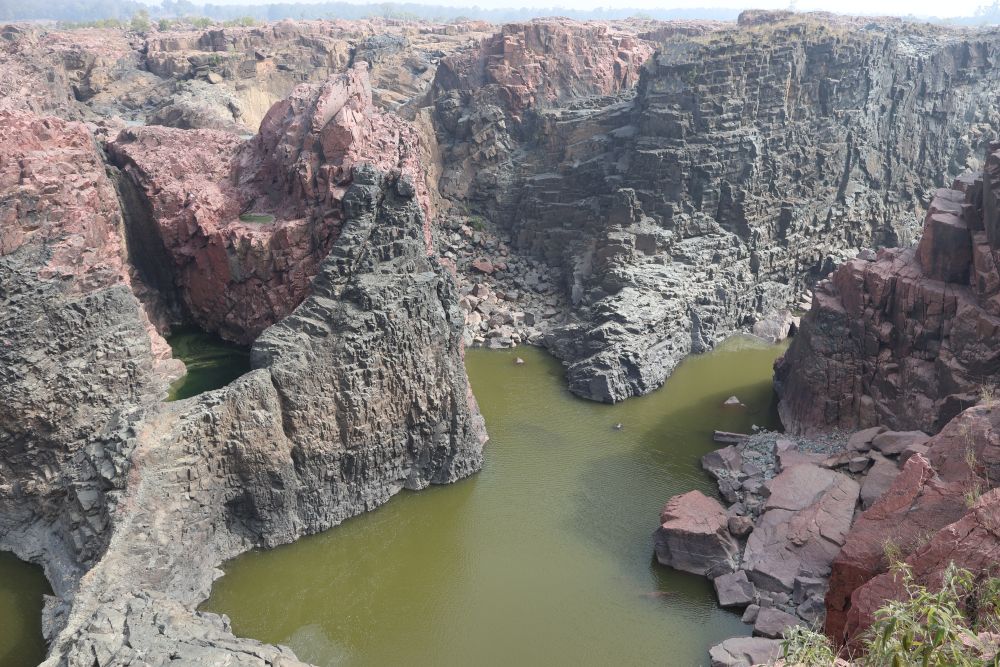
What’s interesting here is that, unlike the Grand Canyon, this gorge doesn’t seem to have been carved out by water erosion. It looks like the land has broken, or just cracked open here. The rocky sides of the gorge are full of shattered edges. According to our guide – it is required to pick up a guide at the entrance to travel with you in the park – it’s the result of a volcano. From the lookouts above the gorge, neatly paved with stairways and walkways, it is possible to see several different kinds of rock. Geologists would love this place.
We visited in January, the dry season, and the waterfall itself was pretty minimal. Our guide compared it in the wet season to Niagara Falls, but again I doubt that. Apparently, while we could see much of the gorge (and some crocodiles sunning on rocks), if you go there in the summer monsoon season, you’ll see lots of waterfalls but very little of the gorge. The water level in the river rises to fill the gorge.
What we most enjoyed on this outing from Khajuraho was the Ken Ghariyal Sanctuary. Driving along a bone-jarring dirt road through an area of dry deciduous forest, we spotted lots of wildlife. We saw quite a few Nilgai antelopes, some wild boars, several different kinds of monkeys, and lots of different birds. Cows and domestic buffalo from a nearby village also share this land.
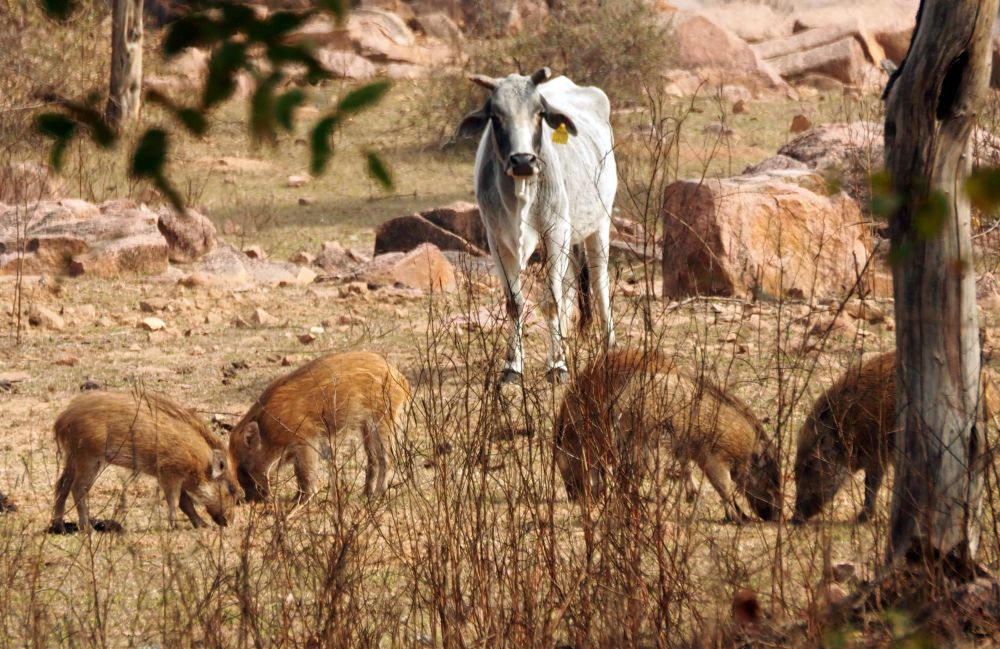
Panna Tiger Reserve
Our guide at Ken Ghariyal said that the sanctuary is actually part of Panna Tiger Reserve, but clearly they are separate operations, at least in terms of entrance fees. We decided, after visiting Ken Ghariyal, not to visit Panna. We were both feeling a bit tired and just wanted to take a relaxed day where we were staying. What I can tell you is that you have to visit on a tour – either group or private. Tours leave very early in the morning or in the late afternoon, and sometimes a night safari is possible as well.
You’ll see the antelopes, monkeys, boars and birds that we saw. If you’re lucky, you’ll also see tigers and even, perhaps, leopards.
Panna Tiger Reserve’s website.
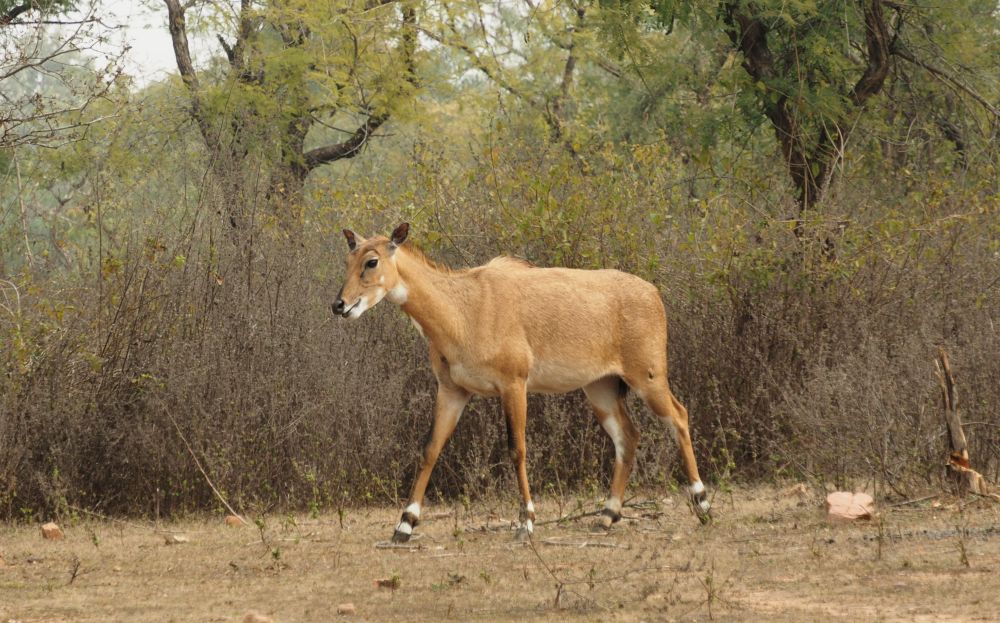
Tips for visiting Khajuraho
We stayed at Rancho Khajuraho, which was a pleasant homestay with a really kind and helpful family. There are also plenty of other hotels in Khajuraho. Use the map below to compare accommodations:
We hired a tour guide for a full-day temple tour. It wasn’t cheap, but we got a government-approved tour guide who was extremely knowledgeable. Seeing the site with this tour guide meant we didn’t just gawk at erotic images but were able to understand the philosophy behind many of the images.
If you nevertheless prefer to see the temples on your own, use the map above to find accommodations within walking distance – Khajuraho isn’t a big town. See the Western Group first, then decide if you want to see more. Be warned: you will get hassled by touts wanting to sell you souvenirs or lure you into their shops. Either ignore them or just say “No” firmly.
Unless you want to rent a car and brave the crazy Indian roads, you’ll need to hire a driver and vehicle to see Panna Tiger Reserve or Raneh Falls Ken Ghariyal Sanctuary. We went by tuk-tuk, but that was probably a mistake, given how rough the roads in the sanctuary are. I’d suggest a more rugged form of transportation like an SUV. The guide assigned at the sanctuary joined us in the tuk-tuk and was very helpful in spotting animals and birds. You are expected to tip the guide. Try this tour to Raneh Falls Ken Ghariyal.
As for Panna, they are stricter. You need to book a tour beforehand and can only enter in a government-approved vehicle. They limit how many vehicles per day can enter, so make sure to book ahead. All the details are on the reserve’s website. Click on the images below to see some of the tours that are available:
If you hire a taxi driver and/or guide in town to go to any of the sights, you’ll have to pay in cash. Agree a price ahead of time and add a tip, assuming the work is satisfactory. If you book via GetYourGuide or similar, like the tours in the images above, you’ll pay ahead online, but you should still tip both driver and guide.
For Raneh Falls, the time of year that you visit will make a big difference. We visited in January and the falls were at their lowest ebb. However, that meant we had a very good view of the gorge itself. Visit right after the monsoon season – October or November – and you’ll see some pretty astounding waterfalls, but little of the gorge.
Ken Ghariyal Sanctuary is closed in the monsoon season: July, August and September.
Panna Tiger Reserve and the temples are open all year.
If you’ve been to any of these – particularly Panna Tiger Reserve – please add your observations in the comments below!
My travel recommendations
Planning travel
- Skyscanner is where I always start my flight searches.
- Booking.com is the company I use most for finding accommodations. If you prefer, Expedia offers more or less the same.
- Discover Cars offers an easy way to compare prices from all of the major car-rental companies in one place.
- Use Viator or GetYourGuide to find walking tours, day tours, airport pickups, city cards, tickets and whatever else you need at your destination.
- Bookmundi is great when you’re looking for a longer tour of a few days to a few weeks, private or with a group, pretty much anywhere in the world. Lots of different tour companies list their tours here, so you can comparison shop.
- GetTransfer is the place to book your airport-to-hotel transfers (and vice-versa). It’s so reassuring to have this all set up and paid for ahead of time, rather than having to make decisions after a long, tiring flight!
- Buy a GoCity Pass when you’re planning to do a lot of sightseeing on a city trip. It can save you a lot on admissions to museums and other attractions in big cities like New York and Amsterdam.
Other travel-related items
- It’s really awkward to have to rely on WIFI when you travel overseas. I’ve tried several e-sim cards, and GigSky’s e-sim was the one that was easiest to activate and use. You buy it through their app and activate it when you need it. Use the code RACHEL10 to get a 10% discount!
- Another option I just recently tried for the first time is a portable wifi modem by WifiCandy. It supports up to 8 devices and you just carry it along in your pocket or bag! If you’re traveling with a family or group, it might end up cheaper to use than an e-sim. Use the code RACHELSRUMINATIONS for a 10% discount.
- I’m a fan of SCOTTeVEST’s jackets and vests because when I wear one, I don’t have to carry a handbag. I feel like all my stuff is safer when I travel because it’s in inside pockets close to my body.
- I use ExpressVPN on my phone and laptop when I travel. It keeps me safe from hackers when I use public or hotel wifi.


